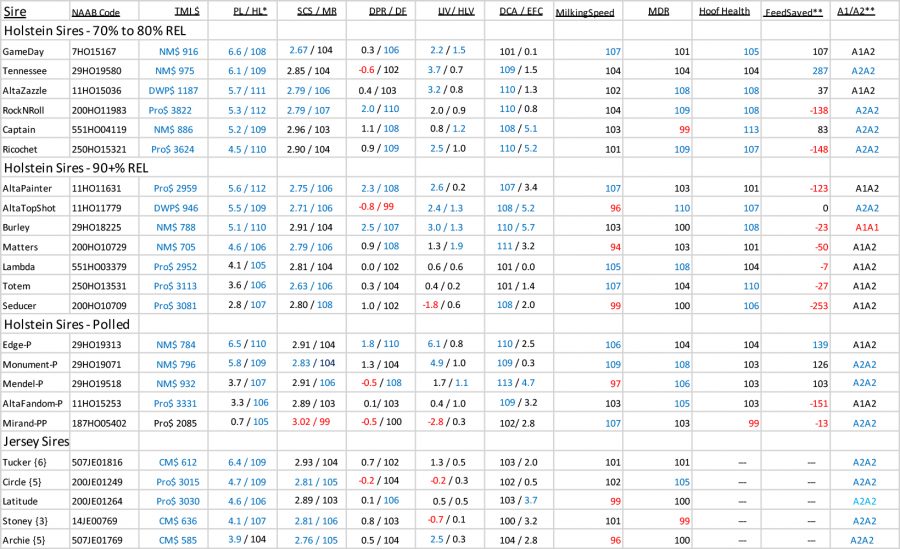Going forward dairy farms will be more automated, larger and more business and systems (field to consumer) based. On the animal side dairy cattle breeding will be focused on productivity, efficiency, health, reproduction, welfare and the milk consumer will demand. An informative document looking to dairying in the future is the USDA-Economic Research Service July 2020 Report (#274) – Consolidation in U.S. Dairy Farming. It is recommended reading for all dairy farmers. It accurately reports many past changes and predicts future changes in dairy farming.
No Time to Waste in Planning Breeding
Breeding decision in 2021 will result in female calves bring born in 2021-2022. By 2025 those calves will be the major part of milking herds. There is no time to waste in deciding on the elite sires that will produce the cows dairy farmers will need in 2025 and beyond.
Where have Past Total Merit Indexes (TMI’s) Landed Dairy Breeders?
TMI’s came on the dairy cattle breeding scene over thirty years ago for the purpose encourage breeding for more than a single trait – yield or conformation.
Fast forward to today and we see promotion, buying and using focused on one number – the TMI. So, like thirty years ago, the breeding industry is focused on a single value. It is all about being #1 without regard for the fact that even the #1 sire will have performance limiting traits.
The objective of North American TMI’s (NM$, CM$, TPI, JPI, LPI, Pro$, …) has been to increase lifetime performance and they have assisted breeders in increasing genetic merit for milk, fat and protein yields and improved mammary systems … However, the result has often been animals genetically deficient in longevity, fertility, health, disease resistance or mobility.
Tomorrow’s Breeding Strategies Must Be Big Picture
Cattle breeding is about producing improved animals that will be productive, efficient, environmentally friendly, healthy, fertile, consumer friendly … in the future. Yet TMI’s, the key industry strategic planning tool, are based on history and an incomplete list of future important traits. So, are TMI’s a breeding tool for breeders or a marketing tool for sire owners?
It is time to find ways to help tomorrow’s dairy farmers use genetic indexes to position their herds genetically for business success. The fact that more and more data for an expanding number of traits has been and will continue to be captured, analyzed and reported for genetic improvement purposes is no small part of what must be addressed.
Is weighting and combining the multitude of traits into a single number/index the route to follow? And one genetic number to cover all farming scenarios, herds and cows – now that seems like an impossibility.
Current Top Ranked Sires Have Limiting Factors
A study of the top 20 Holstein and 10 Jersey (Dec’20) proven sires in six widely used North American public or breed TMI’s (NM$, CM$, TPI, JPI, LPI & Pro$) shows 60-70% of the functional trait sire indexes for this group of sires are only average* or below average for seven important functional traits.
A high TMI ranking is not the final answer on whether a sire should be used for a mating or for a herd’s genetic improvement.
A synopsis of our findings shows:
- 40% of sires did not have a single functional trait for which they are an improver*
- For only 5% of all the sire ratings are elite improvers*
- Only 10% of the sires had improver* ratings for five of the seven functional traits
- Only 1% of the sires have improver* or elite* ratings for all seven functional traits
- Below average ratings occurred more often for fertility traits compared to longevity and udder health traits
- Holstein sires had a higher occurrence of below average ratings for fertility than other traits
- Jersey sires had a higher occurrence of below average ratings for udder health than other traits
The facts tell the truth – most sires at the top of North American TMI index listings have a deficit of improver* or elite* indexes for important functional traits.
*Proof levels to designate average, improver and elite can be founding in The Bullvine article “Don’t Ignore Selection Intensity When Selecting Sires!”
An Overview of Functional Traits**
Currently there are genetic indexes for over twenty functional traits – body part functions, fitness, health, disease resistance and welfare. Data capture organizations and genetic evaluation centers have done a very good job of collecting the data and providing useful reports and indexes to dairy farmers for functional traits. Dairy cattle breeders have used functional trait indexes information to greatly improve udder health and calving ease. Yet sire genetic indexes for daughter longevity and daughter conception rates are not used by all dairy farmers to an equal level when purchasing semen.
Here are eight new (in 2018-2020) functional traits that provide dairy farmers the opportunity to position their herds for the future:
Performance Traits
- Milking Speed (MS) – Speed of through-put through parlors/stall robots is particularly important for labor utilization and number of cows that can be milked through a facility. MS genetic indexes are produced but are rarely included in TMI’s.
- Early First Calving (EFC) – This index predicts the months saved or extended to first calving. Each month amounts to $100/month saved or added to heifers rearing costs. CDCB will be adding EFC to the NM$ and CM$ formulas.
Health Traits
- Livability – ‘LIV’ is closely correlated to longevity (PL or HL). It is important that milking cows be able to overcome setbacks. Heifer Livability (HLV) indexes were published for the first time in December. LIV and HLV are not included in all TMI indexes.
- Hoof Health (HH) – The health of animals’ feet is important in herd management, milk production, staff’s time-use, treatment costs, … and thereby to profit. For a complete report on HH read “Put Your Best Foot Forward”. As yet, HH indexes are not included in North American TMI’s.
- Metabolic Disease Resistance – Lactanet produces a combined index (MDR) for metabolic diseases while CDCB produces individual trait indexes for milk fever (MF), displaced abomasum (DAB) and ketosis (KET). None of these indexes are, as yet, included in North American TMI’s.
Reproduction Traits
- Haplotypes – Each breed has haplotypes that negatively affect fertility. It is not necessary to eliminate sires that carry haplotypes as breeding companies screen out sires that are carriers for haplotypes. No need to include them in TMI’s.
- Post Calving Disorders – Genetic indexes are published for various disorders including retain placenta (RP), cystic ovaries (CO) and metritis (MET). All need to be avoided to achieve high reproductive performance. These are not included in TMI’s.
Efficiency Trait
- Feed Saved (FS) – CDCB introduced, in December, the genetic index FS which ranks sires by the relative feed cost ($) for a standardized production level of their daughters compared to the breed average. This index has already been produced or will soon be produced in other countries. CDCB plans to include FS in NM$ and CM$ in April 2021. Lactanet is studying sire indexing for feed efficiency. Dairy farmers can expect to read more about sire genetic indexing for daughter feed conversion efficiency. In time feed efficiency will be included in most TMI’s.
Dairy farmers will see other indexes and designations that also rate sires for daughter feed conversion efficiency including EcoFeed (StGen), FE (Holstein USA) and breeding company listings.
Dairy breeders can expect to see genetic indexes for additional functional traits in the future. Indexes for traits such as – Johnes resistance, heifer growth, labor efficiency, animal mobility, …etc.
Identifying and Monitoring Herds for Functional Traits
With so many functional traits it is almost impossible to have a herd that does not have at least one trait for which the herd has a problem or is below breed average.
Two methods exist to identify and monitor herds for functional traits: 1) genomic test all replacement females; or 2) choose 3 -4 functional traits for the herd and then average the indexes for the nearest three nearest sires. Alternative #1 will be more costly and more accurate but it does provide a more complete herd picture for both breeding and managing purposes.
Including Functional Traits in Sire Selection
The Bullvine offers a three-step method to include function traits in sire selection:
- Step #1
Set a minimum value for the TMI you prefer to use (i.e. Holstein NM$ 650, DWP$ 500 or ProS 2,500 / Jersey CM$ 400 or Pro$ 1,500). Only consider sires above those minimums.
- Step # 2
From the sires identified in step #1, eliminate all sires that are below the proven sire average for all three of: PL (Holstein 2.3 / Jersey 1.8), DPR (Holstein 0.0 / Jersey 0.0) and SCS (Holstein >2.91 / Jersey >2.99). For Canadian indexed animals eliminate sires below 102 for any of HL, DF and MR.
- Step #3
Beyond those first two elimination steps, decisions on which sires to buy or use should be based of herd goals or functional traits needing improvement in the herd.
Breeding companies have trained specialists who can assist dairy farmers in evaluating their herds and moving to selecting sires for functional traits.
North American Sires with the “GOODS” for Functional Traits
Table 1 contains some of the current elite North Animal sires for functional traits.
Table 1: North American Sires with Elite Functional Trait Indexes (Dec ’20)
* Sires are listed in order of PL
** Feed Saved and A1/A2 are included for information purposes.
Coding: Blue – improver; Black – average; & Red – below average.
Benefits of Selecting Sires and Culling Herds for Functional Traits
Dairy farmers in the Nordic Countries have been culling their herds and selecting sires for functional traits since 1978. The result has been improved fertility, less sickness, less disease, less lameness, lower herd turn-over and more profit.
After putting a focus on selecting for key functional traits for two generations (5-7 years), North American dairy farmers can achieve as reduction in expense per cow per year of $300. For a 500 cow herd that is $150,000 per year – a very worthwhile achievement. And, that can be done without spending more for semen.
The Bullvine Bottom Line.
Dairy farmers are continually fine tuning their farming and cattle breeding programs. Where once genetic selection was focused on production and conformation, genetic indexes are available or will increasingly become available to select for traits that support digging deeper into reducing the costs associated with feed required, reproduction, animal health and welfare, body functions and rearing herd replacements.
Planning for both animal and herd futures takes vision and goals. The Bullvine encourages all dairy cattle breeders to expand their use of genetic indexes. As sires account for over 90% of a herd’s genetic improvement, refining and focusing sire selection to include more economically important traits will be a wise business decision. May breeders have much success using the genetic indexes for functional traits.
Get original “Bullvine” content sent straight to your email inbox for free.


















